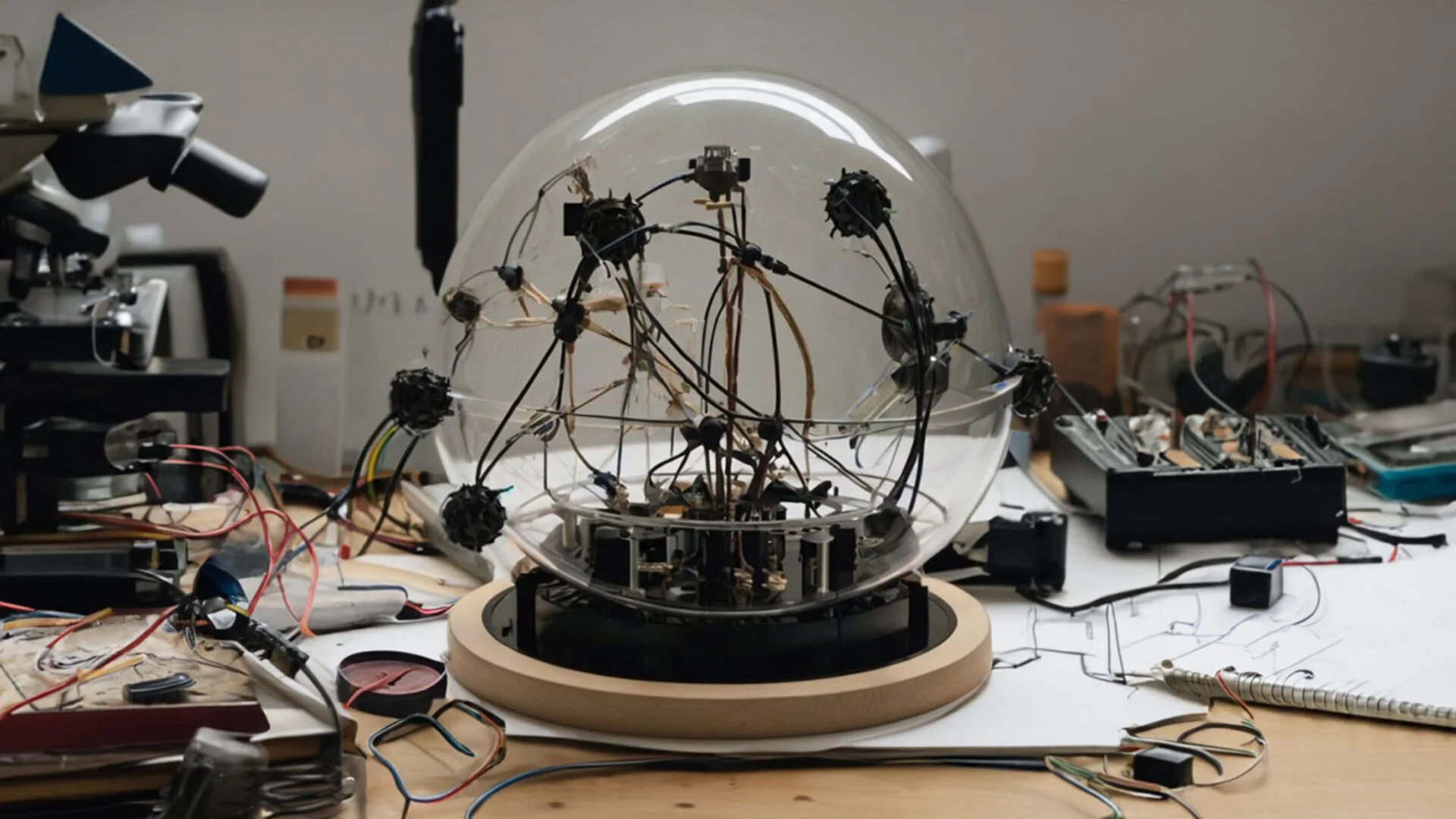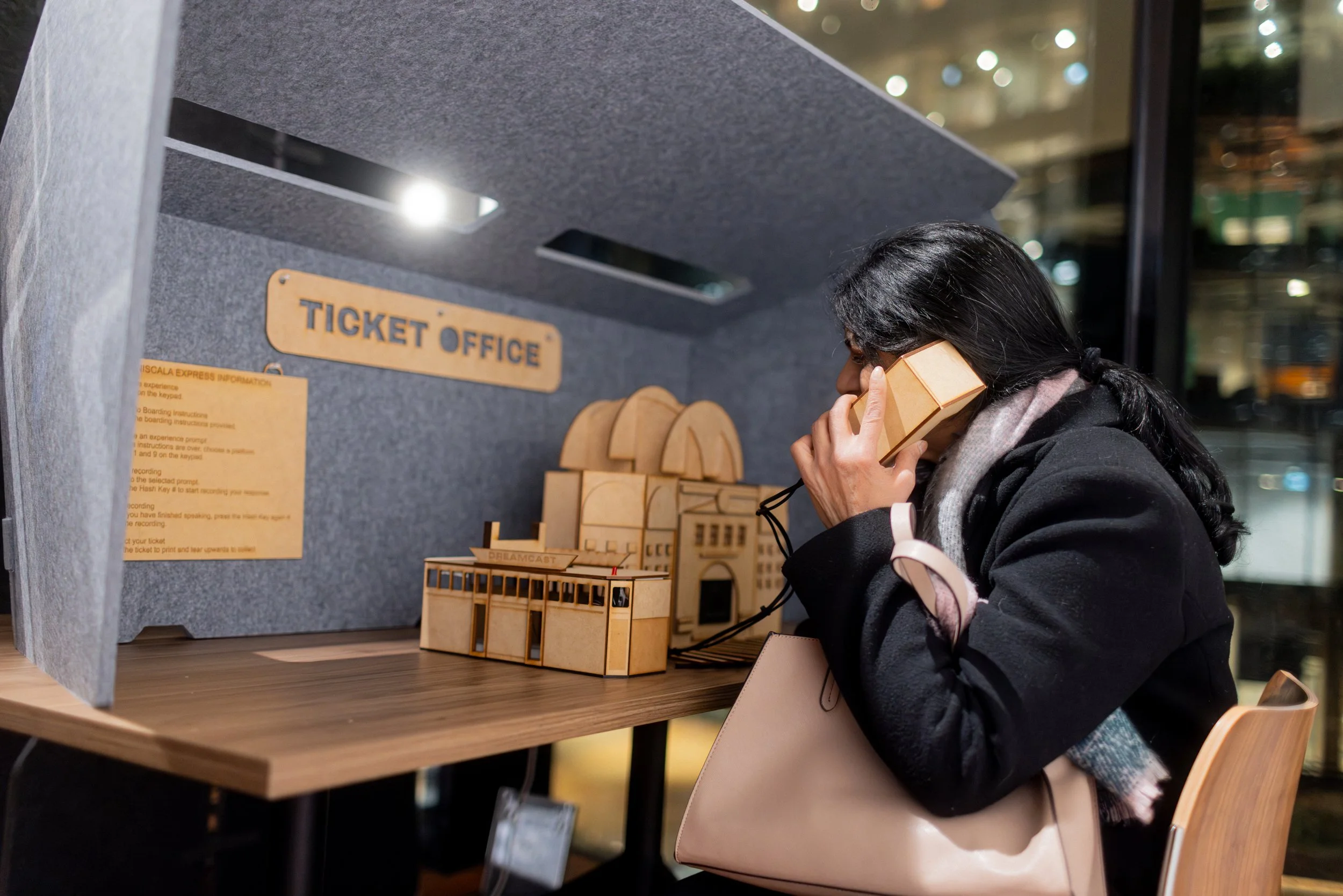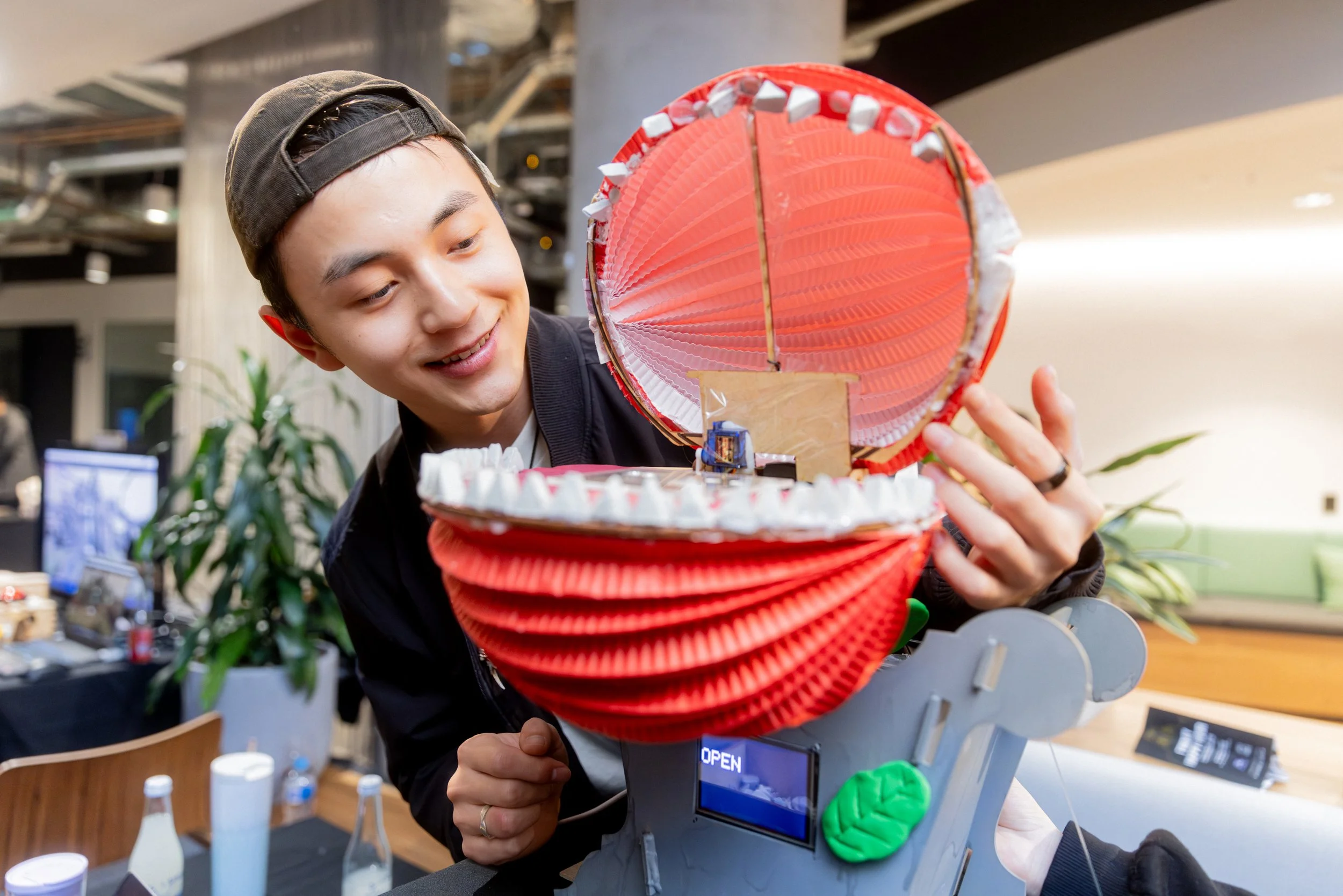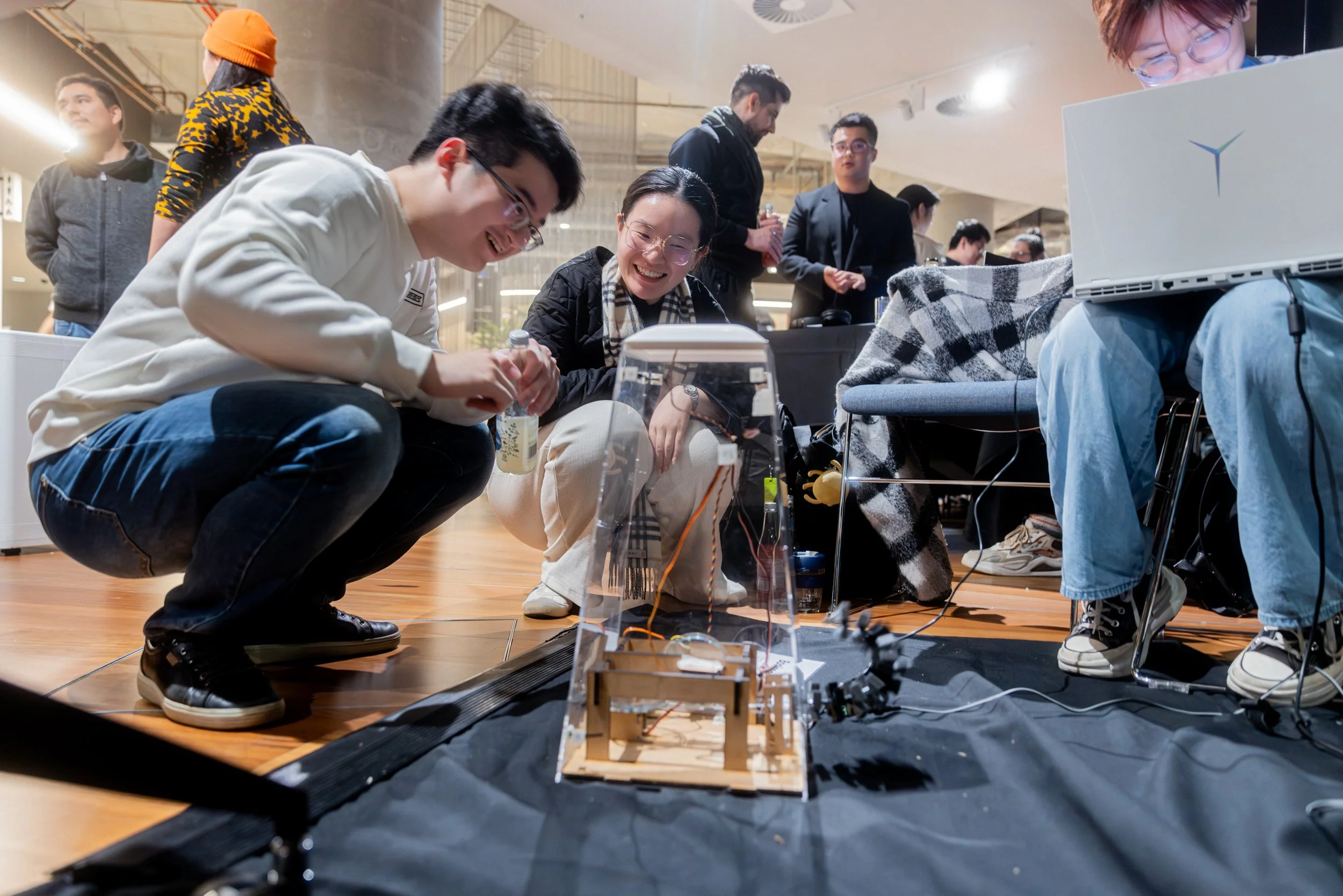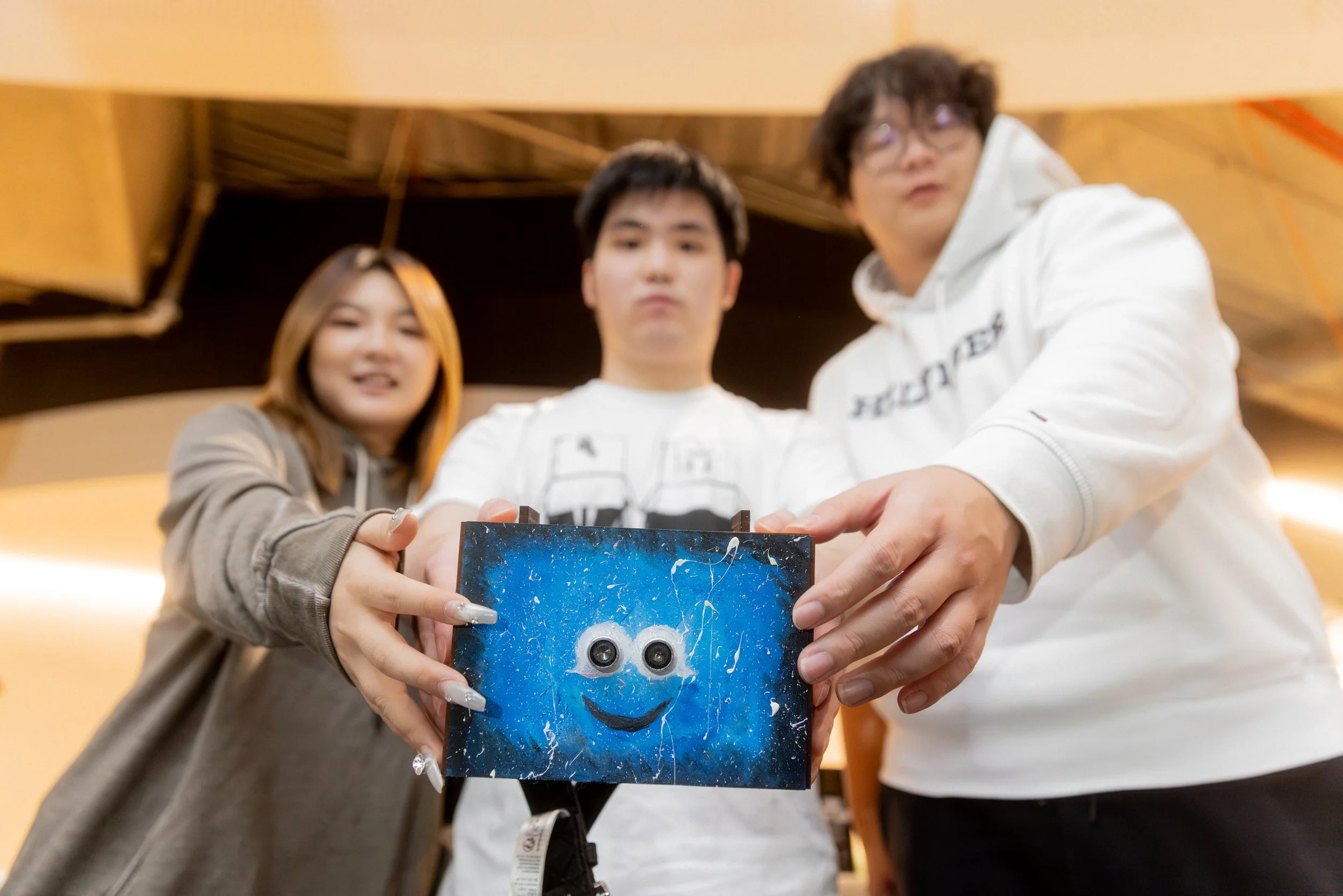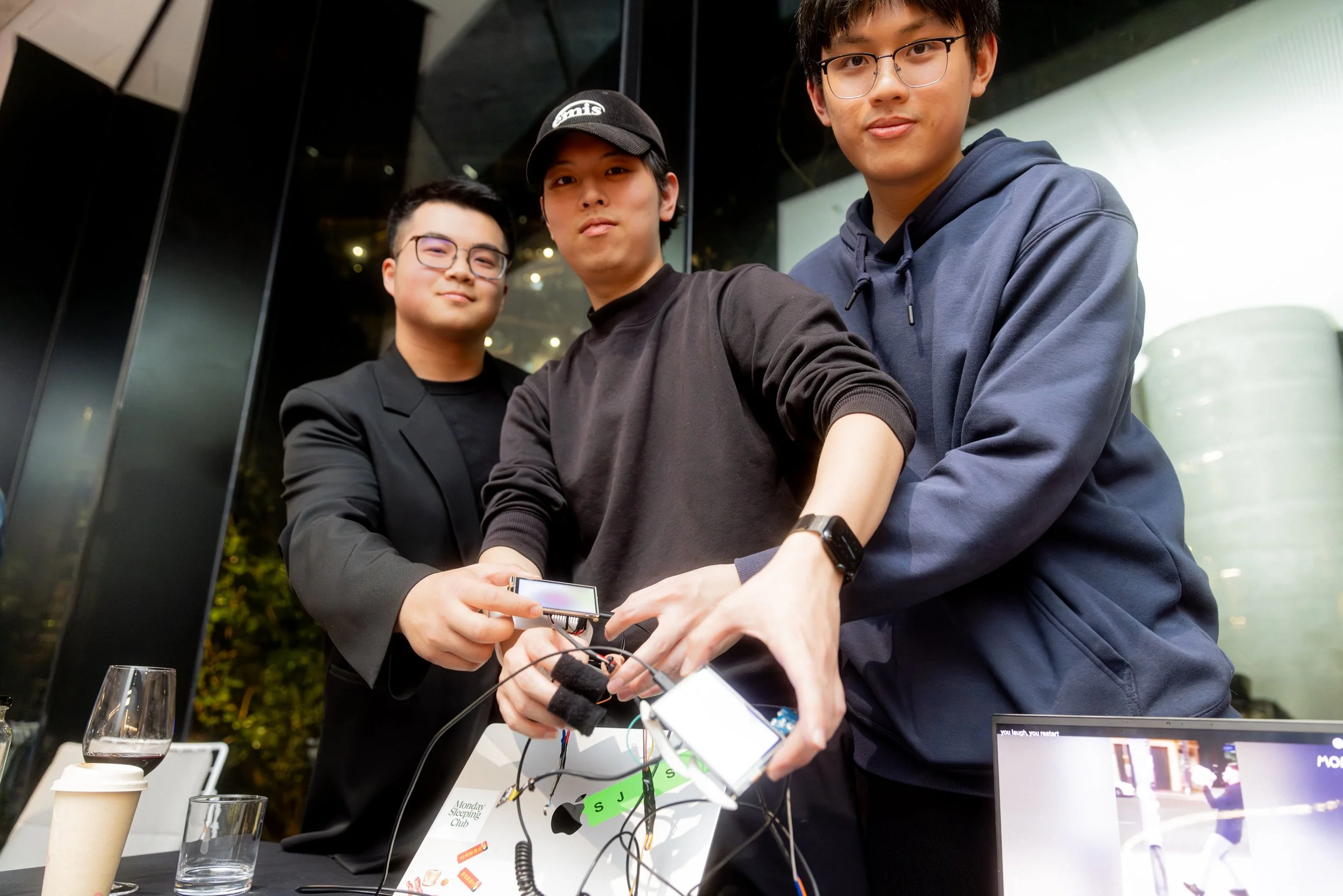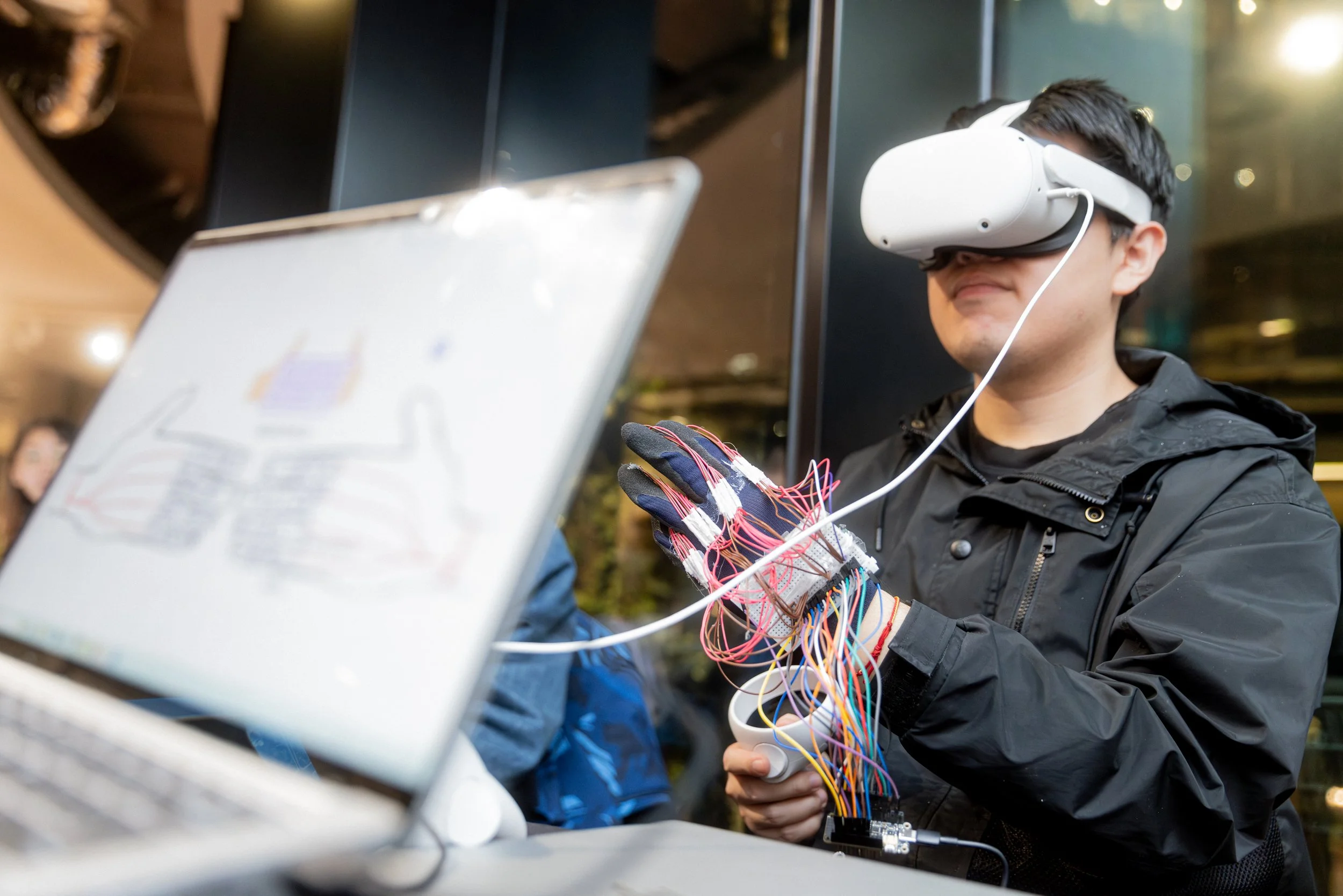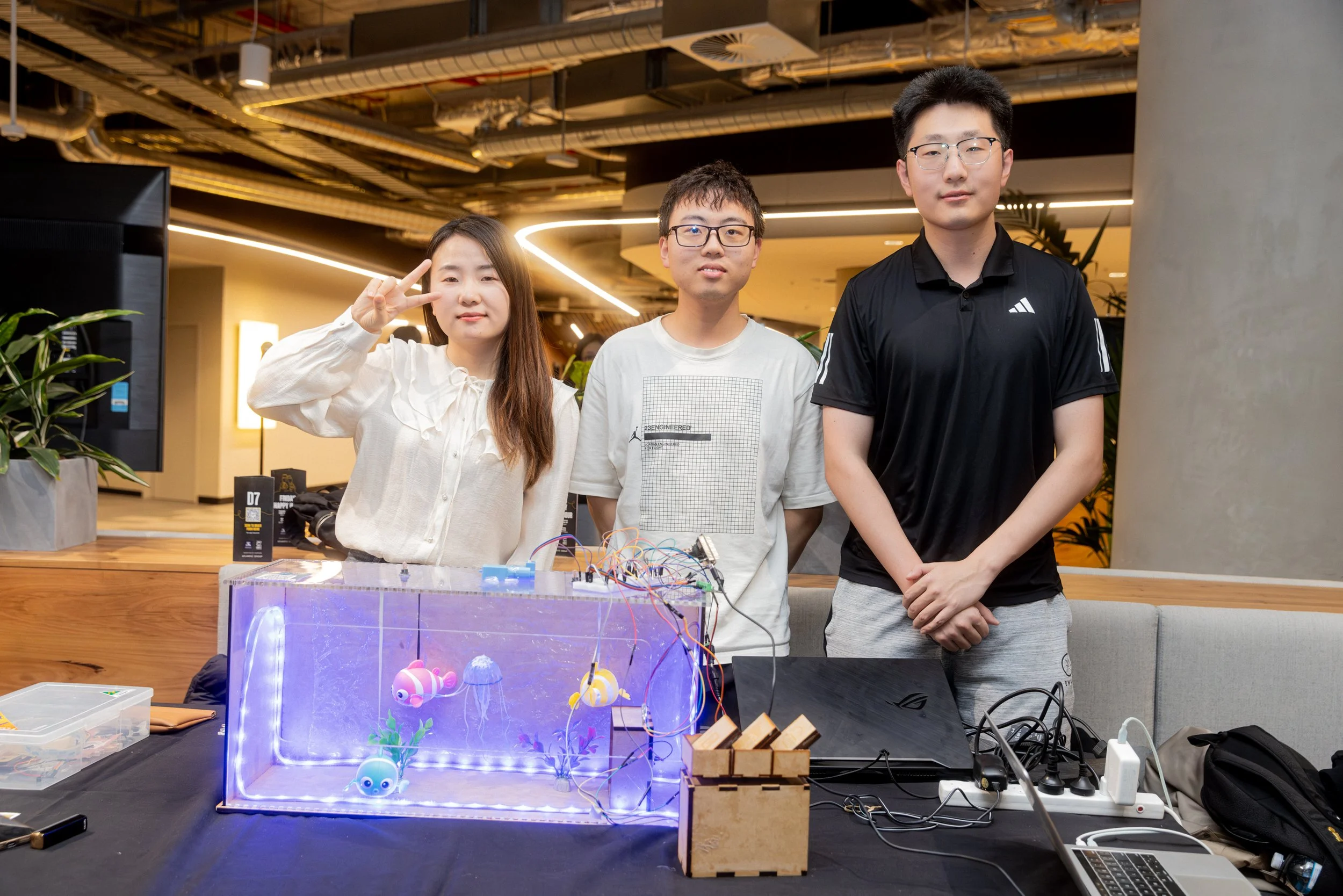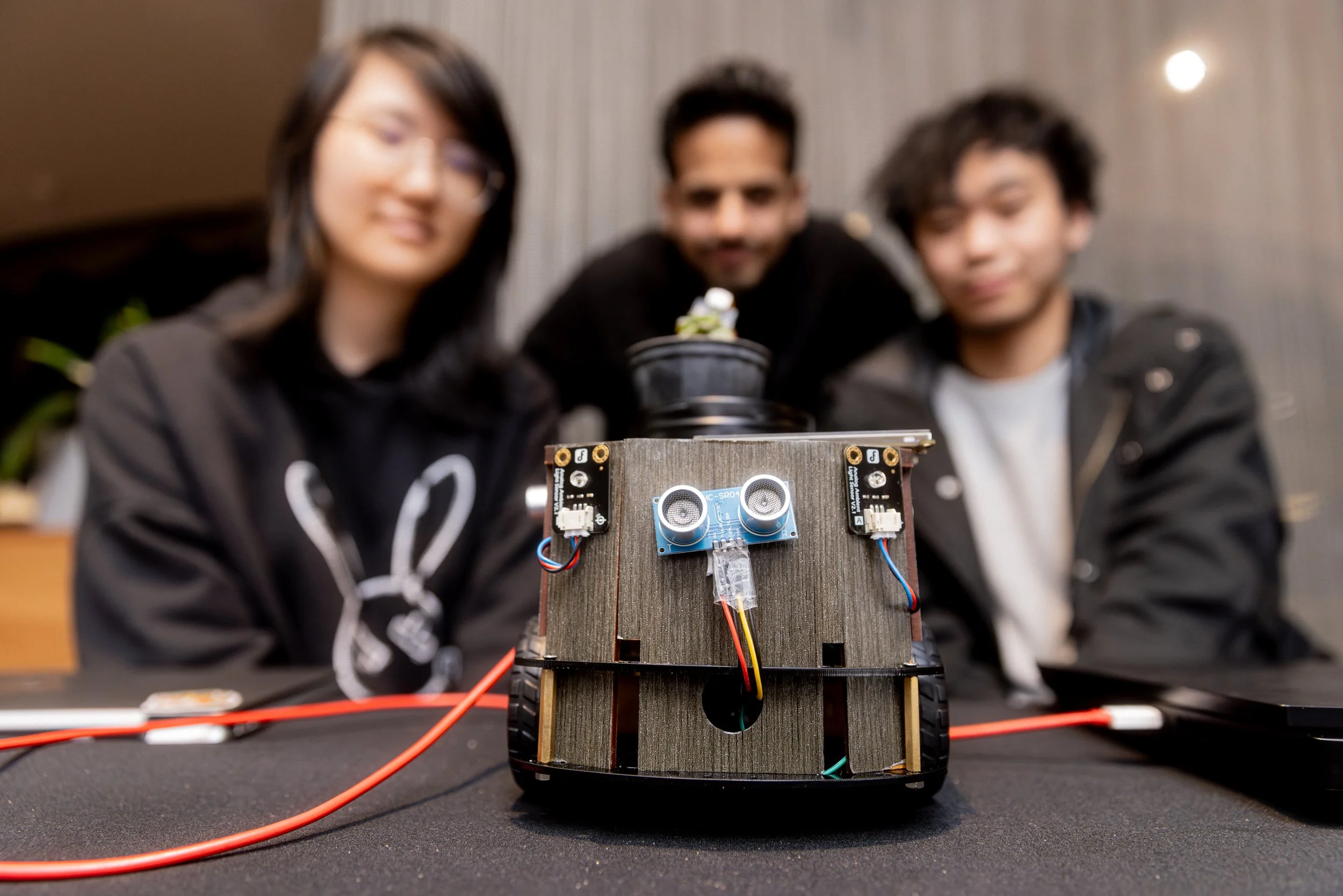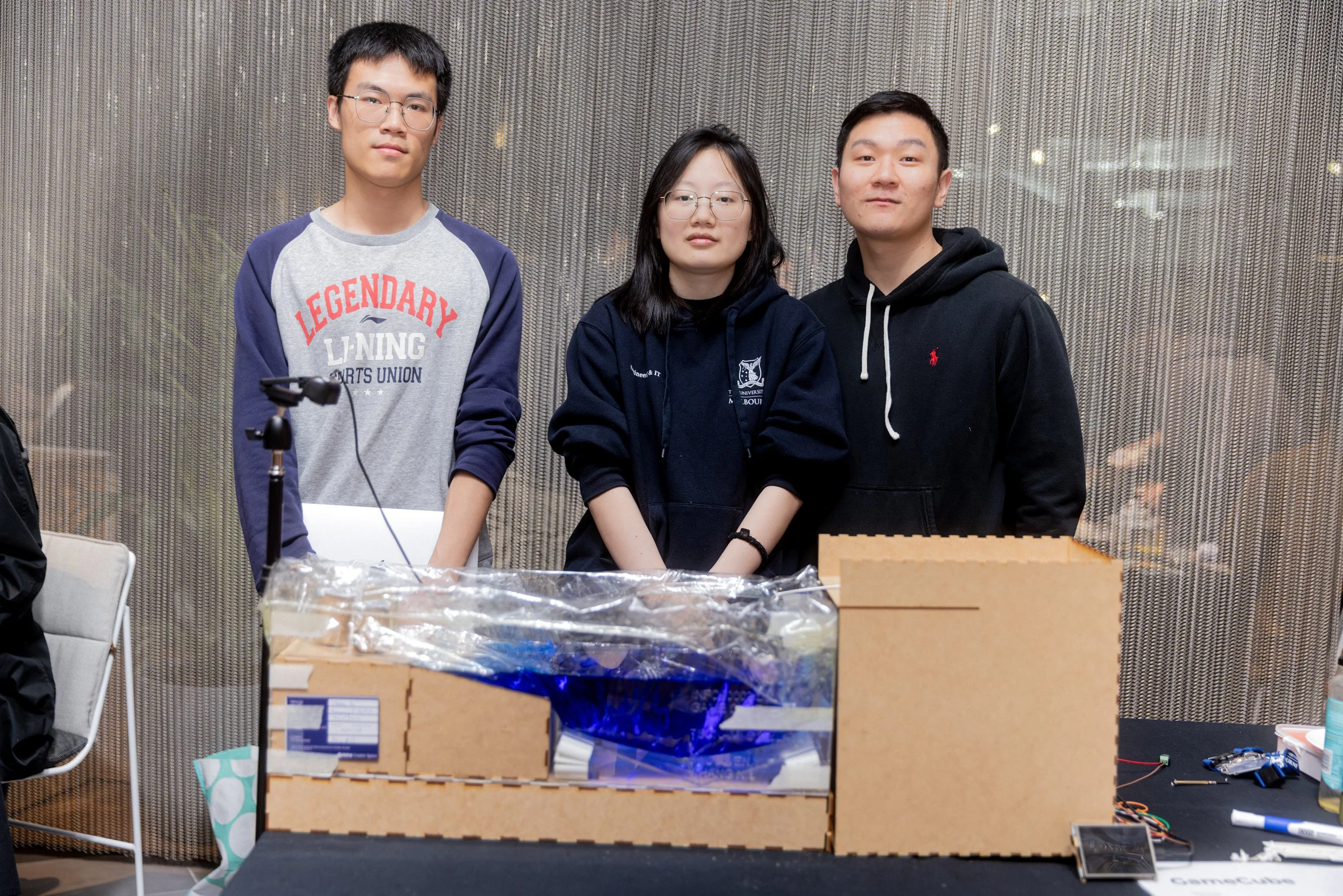Cybernetics Futures Showcase
~*~*~
2024
~*~*~
Cybernetics Futures Showcase ~*~*~ 2024 ~*~*~
The School of Computing and Information Systems of The University of Melbourne invites you to join them at the 2024 Cybernetics Futures Showcase.
This exhibition features over 30 physical computing prototypes made by the Designing Novel Interactions students that examine the future relationships between natural and technological systems. By reimagining both existing systems and speculative new ones, they present not only design solutions but also problems and perspectives that need our immediate attention.
As part of their master’s program, computing students are encouraged to break free from the screen, mouse and keyboard to utilise a range of techniques from embedded systems, wearable electronics, digital fabrication, interactive methodologies and more to extend their practice and build technologies intentionally and critically for the future we want to see.
Designing Novel Interactions is led by Mel Huang, Dr Antony Chacon, Dr Adelaide Genay and Dr Arzoo Atiq from School of Computing and Information Systems, Faculty of Engineering and Information Technology, The University of Melbourne.
This event is supported by the mentorship and guidance of Science Gallery Melbourne and Telstra Creator Space.
EXPLORE VIDEOS AND REPORTS
1 Dreamcast
Linggar ANDARU
Keanan KHOR
Gabriella Sekar SHADA
Benjamin WALD
-
NISCALA explores the interaction between human emotions, memories and interactive technologies. Our focus is to find an equilibrium between the emotional connection humans have with technology, as well as provide users with a memory to take home with them. By reimagining the phone, and designing our installation based on transport, we have created 9 different prompts for people to interact with. NISCALA transports you through time and encourages participants to record their answers through the phone and allow our prototype to print off a ticket with their response as a memory. This is done through a microphone and speaker that converts the speech to text and sends the text file to a thermal printer for the participants to either take home their memory or pin it up on NISCALA station.
MDF laser cut, Thermal printer, Adafruit Feather ESP32 V2 microcontroller, OpenAI Whisper (speech-to-text) module, USB Microphone, USB Speaker, Red LED, 12 keys keypad, Desk Hood, Partitiion board (exhibition design)
-
2 Canberra
Sixuan CHEN
Soma HAYASAKA
Jiayuan LI
-
The "Painting of the Sun" project creates an outdoor mural using special photosensitive paint that transforms under direct sunlight.
This artwork dynamically changes colors, unveiling images and messages over time through the power of solar energy. This not only showcases the fusion of art and technology but also reconnects the public with nature, emphasizing the role of solar energy in artistic innovation. We developed a prototype that uses sensors to adjust the background color and brightness of videos based on sensor feedback. Each sensor independently modifies a video's brightness, and the installation is showcased on an iPad, demonstrating the evolving concept of the mural.
Light sensor, Color Sensor, Wood box, Adafruit Feather ESP32 V2 microcontroller, I2C Multiplexer, Sticky note, iPhone, iPad
3 Crystals
Ying Qi LAU
Xin XU
Jie ZHANG
-
Discover the magic of answers with our interactive 2-degree-of-freedom robotic arm! Inspired by the mystical "Book of Answers”, this innovative prototype invites users to engage in a fun and intriguing experience. Users begin by posing a question in their mind, interact with user interface, and click “Submit”. Watch in amazement as the robotic arm moves to a point and selects one of the answer cards. The physical interaction, combined with the suspense of receiving an answer, can foster optimism and reflection, making users more open to positive possibilities and outcomes. Whether for entertainment or curiosity, our robotic arm is sure to spark fascination and wonder.
Adafruit Feather ESP 32 V2, Servo motor FS5109M, Stepper motor 28BYJ-48, Motor driver, 3D printed shaft coupler, 2 links (MDF), MDF base with cards, Finger pointer, Breadboard, Laptop
4 Sega
Tori LI
Xuan WU
Shuyu ZHUGE
-
Is “natural” a synonym for “good”? Is “not natural” hinting “bad”? However, this oversimplified dichotomy doesn’t summarize human’s relationship with the artificials: artificials can be used against us and to assist us.
In the MindBrew Project, you can try out how mundane artifacts impact the brain’s sleep-wake cycle. To wake up the brain, would you pat it or simply feed it a cup of coffee? How many cups of coffee can the brain endure per day? How can the use of smartphones help or disturb the brain?
Moving beyond the dichotomy, MindBrew explores how we might navigate the inevitably more artificial world, where a critical first step is to “Know Thyself”.
Adafruit ESP32 V2, Distance Sensor, NFC Reader, Magnetometer, Magnet, Human Brain Model (3D Printed), Coffee Cup Model (3D Printed), OLED Screen x 2
5 Kelvin
Emily TRUDGEN
Jiayi WU
YiTong ZHANG
-
When you play Vivaldi's ‘The Four Seasons’, does a scene of vibrant nature come to your mind?
What is unfolding in front of you is our instrument-nature interaction installation "My Virtual Land". It allows you to construct your own immersive visual and auditory experience through the instrument. Each of the seven white keys imports a different visual element to the scene, while each of the five black keys displays a different sound from nature, which can be layered on top of each other to create a variety of harmonious sounds. We hope this device will be widely used in yoga, ballet or meditation classes in the future. The console next to the device has more hidden functions, please have a explore!
Arduino Feather ESP32 V2, Big Dome Push Button, Rotary Potentiometer, Soft Tactile Button, Mini Push Button Switch, Laptop, Monitor, Speaker, Piano Prototype (3d printed + laser cutted), Unity, BreadboardDescription
6 Metres
Andrea BREJCHA
Wenzheng DU
Hiu Wah LAM
Stuti PANDE
-
Gossiping Birds is a creative and humorous reinterpretation of the bird song.
Birds sing a variable song resembling realistic calls in response to viewers interaction. A computer generates a script or “translation” of the conversation occurring between the birds, which alters based on the detection of human presence. The idea is that the birds are gossiping between themselves and are being exposed by the live translation.
Laptop, Adafruit Feather ESP32 V2, Ultrasonic sensors, Servo motors, 3D printed bird models, Timber ledge, Laser-cut internal supports
7 Perth
Jinrun JI
Dongyu LANG
Yue ZHANG
-
Let me keep it for you!
People are becoming increasingly obsessed with mobile phones because of social platforms. Sometimes, studying and working can be interrupted, and people can't concentrate. Our design, the "Cannibal Flower”, is a unique device created to help individuals eliminate distractions by putting phones away and consequently creating more time to focus.
Users can place their phone inside the mouth of a flower-shaped device, which then closes and locks for a predetermined period. The flower's mouth remains closed, preventing access to the phone until the countdown timer reaches zero. This playful and engaging design encourages users to focus on more important tasks without the temptation of their mobile phones.
Adafruit ESP32 Feather V2, Micro Servo FS90, Adafruit TFT FeatherWing, Beam Load Cell, Makerverse Load Cell Amplifier HX710, Breadboard, Jumper Wire 20cm Ribbon, Universal AC Adaptor, Battery & Battery Holder / Laptop & Type-C Cable , Laser cut MDF & Acrylic
8 Booleans
Zhengzi JIANG
ShengSheng LI
Muqing GUO
-
Does it feel real? Even just for a second?
The development of artificial technology has advanced to the point where we are able to create airplanes inspired by birds, submarines inspired by fish, solar energy generation by mimicking the mechanism of photosynthesis in plants. We have delved into the field of recreation of natural structure and functionalities, what else can we explore?
As technology evolves, the boundary between natural and artificial blurs, can we evoke natural feelings without relying on natural objects? Come in and experience it for yourself!
A sensor holder. An acrylic body part. A moving thing.
9 Doubles
Han LI
Kexin TAN
Guoxuan WANG
-
The blind person range alert device is crafted to boost mobility and ensure safety for blind or visually impaired individuals by delivering real-time alerts about nearby. It incorporates ultrasonic sensors that detect objects within a certain range. Thus preventing collisions. The device provides vibrational feedback, where the frequency and intensity of vibrations increase as the user nears an obstacle, offering intuitive guidance. Additionally, it features audio alerts that escalate in frequency as one approaches obstacles, adding another layer of sensory information. The device's wearable design is lightweight and can be worn around the body. It also includes adjustable sensitivity settings, allowing users to customize the detection range and alert types based on personal preferences and environmental conditions.
Feather ESP 32 V2, FeatherWing V2, MPU6050 Sensor, HC-SR04 Ultrasonic Sensor, DFR0032 Digital Buzzer Module, Polymer Lithium Ion Battery (LiPo), Mini vibration motor 2.7mm (Seeed Studio), Laser Cutting
10 Playstation
Han WANG
Aoxiang XIAO
Jiuyu ZHU
-
This bracelet collects biometric data, including galvanic skin response (GSR) and heart rate, to interpret and visualize emotional variations on its integrated screen. Simultaneously, it communicates these emotional shifts to a paired bracelet, which conveys the changes through distinct vibration patterns, allowing wearers to feel the emotions of their counterpart in real-time, creating bidirection emotion communication.
3D Printing Case, AdaFruit ESP32 V2, Grove GSR Sensor, AdaFruit ESP32 TFT Screen, MH-ET MAX30102 Heart Rate Sensor, FIT0774 Vibertor, Cloud
11 Lasers
Yicheng HUANG
Bodi MAO
Ai TSENG
-
Our project involves a speaker glove that utilizes Arduino and Force Sensitive Resistors (FSR) to convert user input into voice and screen output. The glove features FSR sensors on each finger, mapped to specific characters, and a thumb sensor for the "enter" signal. When a user presses a finger sensor, the corresponding character is stored. Pressing the thumb sensor sends an "enter" signal, prompting the system to generate and output the stored text as speech.
For example, pressing Finger 1 and 2 can result in FSR inputs of 'H' and 'I', and pressing the thumb sensor triggers the output "HI" through the speaker and display screen. This intuitive input method allows for real-time text-to-speech conversion, making it an effective tool for individuals with speech and hearing impairments.
AdaFruit ESP32 V2, FSR Sensor, Breadboard, Microcontroller (FLORA), JST PH 3-pin clip cable, Glove, Laptop
12 Sydney
ZECHENG FAN
Tian TAN
Puyan ZHANG
-
We use our fingers to type on keyboards, whether it is a physical button or a touch screen, it helps us interact directly with the digital world. With the soaring popularity of Virtual Reality, we have never been that close to the digital world. Now, we can be one step closer.
Introducing the MagicTough, a wearable finger keyboard that would elevate your virtual experience. A seamless integration of your familiar QWERTY keyboard and a glove, making text input a breeze. Its portability frees you from the confines of traditional input devices. You can dive deeper into immersive worlds, where every typing action is at your fingertips. MagicTouch - a fusion of innovation and convenience.
AdaFruit HUZZAH32 ESP32 V2, Solderless Breadboard, Mini Push Button Switches, Cycling Glove, Meta Quest 2 VR Headset, Polymer Lithium Ion Battery, Laptop
13 Wii
Linjing BI
Tianshu CHU
Jie ZHOU
-
We have designed an interactive demo aimed at advocating for ocean protection and reducing marine pollution. This demo simulates an ocean environment, allowing users to experience the process of picking up trash. After the trash is collected, the marine life becomes active, and the lights in the tank change color from red to green, symbolizing the improvement and cleanliness of the ocean environment.
This design aims to raise awareness about ocean protection and demonstrate the positive impact of individual actions on the environment through interactive experiences. By doing so, we hope to inspire more people to pay attention to marine pollution issues and encourage them to take action in their daily lives to protect our ocean environment.
Pressure Sensor, Motor, AdaFruit EPS 32, RGB LED Light, Adafruit Feather ESP32 V2 microcontroller, Stepper motor
14 Melbourne
Yicheng DU
Zeyu LI
Zirong LIAO
-
We've devised an interactive demo to advocate rainforest protection and decrease deforestation. This display simulates a rainforest environment, raising users' awareness of human threats to rainforests. When users press a force sensor, the pressure reflects human impact on the rainforest. Lighting shifts from green to red, symbolizing the severity of threat and human-induced damage. As pressure on the force sensor increases, trees transition from healthy to dead, illustrating the process of destruction. This design aims to heighten awareness of rainforest protection and showcase the positive impact of individual actions on the environment through interactive experiences. We hope to spark more attention to rainforest destruction and encourage proactive measures to safeguard our rainforest environment.
Arduino Uno Board, LED with different colors, Force Sensor, Servo motors, Laser cutting wood trees & decorate, Laser cutting wood box, Breadboard, Laptop, Wires, USB A To B Cable
15 Kilograms
Yisha CHEN
Shi DONG
Ninghao ZHU
-
The Anthropocene's impact on the natural environment has led to the disappearance of large coral reefs.
Imagine you are a puffer fish, drifting alone without a home, but distance sensors allow you to distinguish between safety and danger. Once you sense that danger is approaching you, you inflate to protect yourself. At the same time, when you feel safe and comfortable, you deflate again, return to your original form and continue your life of floating. In the end, you will find yourself with a cosy, warm home with reefs, seaweeds, starfish and other things you like, and warm lights shining through, which represents a scenario where technology and nature live in harmony.
Air Pump and Vacuum DC Motor, 2 Air Valve, Silicone Tubing, Polymer Lithium Ion Battery, Adafruit ESP32 Feather V2, 2 Channel Relay Module , Single Channel Relay Module, Ultrasonic Distance Sensor, FLORA, 3D printing ocean creatures, LED chain, Coin Cell Battery Holder, 2 Universal AC Adaptor, Wooden box
16 Transformers
Bohan WANG
Junrong WU
Kaijie ZHOU
-
A sand model table is built with models representing cities, industries, agricultures and cargo ships surrounding a harbour (a water tank). By interacting with different models in different ways, sensors will grab the trigger information and the screen under the water tank will display different color that represents water pollution individually. And the diffusion and blending of colors projected onto the water will give a more intuitive view of how those factors causes severe water pollution.
17 Brisbane
Yuanliang SHEN
Xuan ZHAO
-
We implemented a CV-based automatic garbage sorting trash can. When a user places garbage in our trash can and ultrasonic distance sensor will detect there is something. The camera will take a photo of the garbage and sent to an open-source AI garbage classification API. Using the returned classification results, the stepper motor will rotate along with the lid of the trash can, allowing the garbage slide into the correct category.
Ultrasonic Distance Sensor, Camera, Stepper motor, Stepper motor driver, AdaFruit ESP 32, Acrylic board, Mac laptop, CV API
18 Hobart
Yunpeng LI
Jiyang XING
Ziyu YIAN
-
The automatic cat litter machine has 2 main functions:
Automatic Litter Replacement: Found in the upper layer of the prototype, this function uses an Ultrasonic Distance Sensor to detect if there is a cat inside the machine. If no cat is detected, the motor activates gears to dispose of the used litter.
Waste Disposal: On the lower level there is a drawer designed to help users dispose of used cat litter
Ultrasonic Distance Sensor, laser cutted 3mm MDF boards, laser cutted 6mm MDF boards(for gears), Adafruit Feather ESP32 V2 microcontroller, STEP MOTOR 28BYJ-48 5V DC *3, 3D-Printed rake, durable container
19 Integers
Thanh Hoang NGUYEN
Acalapati PRIYATAMA
Sakdiphat TANPHIPHATARI
-
Our prototype showcases a form of touch-based interaction with plants, when touching the plant, you'll be able to play musical notes and even select the types of musical instruments that you want to play with. The plant is connected to a touch shield that's connected to an Arduino board, acting as a MIDI controller. Then in the software side of things, the output of the values produced by the plant when touched is converted with a Python script to musical notes that plays through a DAW (Digital Audio Workstation), specifically on FL Studio. Aside from that, the plant is surrounding with LED lights to show your interactions with it.
Arduino Leonardo, Adafruit 12 x Capacitive Touch Shield for Arduino , MPR121, Solderer, Feather Stackable Header Kit, Jumper Wire 20cm Ribbon, Alligator Clip Cable, Diffused RGB 5mm LED, 3D Printed Geometric Plant Pot (Designed using Fusion 360), 3D Printed LED holder (Designed using Fusion 360), Laptop (for speakers and DAW), FL Studio
20 Strings
Qirong XIE
Buyi TENG
Yanrong ZHANG
-
Don't put me in the dark! I'm a Light-loving Flower~
Our Light-loving Flower is an interactive simulated plant that can rotate around the torch (simulated sunlight). This rotation is driven by an integrated light sensor and mechanical components which is attached to a motor with connectors and bearings, its stem enable motion and rotation. This prototype encourages public interaction, allowing viewers to use torch to directly influence the sunflower's behavior (rotation). This project uses artistic expression to educate about plant needs and promote environmental awareness.
Solderless Breadboard 400 Tie Points(ZY-60), Kitronik Clippable 360 Degree Servo, Light Dependent Resistor (LDR), LED-Basic Red 5mm, Mini Vibration Motor (10*2.7mm), 3D Printed Stem of flower
21 PSP
Yilin CHEN
Zhaoyu QIN
Haoran YANG
Yu ZHOU
-
This prototype is an interactive electronic pet plant that uses OLED facial expressions and audio feedback to simulate real plant care. It responds to proximity, touch, light, and water levels with appropriate expressions and messages. Users can interact with the plant by touching it, providing water, or adjusting light, making the experience engaging and educational.
Arduino Uno board, OLED display, Capacitive touch sensor, Ultrasonic distance sensor, Light sensor, Water level sensor, Speaker, SD card
22 Amperes
Wenlong FENG
Wenyuan WU
Yilin ZHOU
-
This is an electronic potted plant. Touching the petals and leaves of the potted plant will affect its mood and give reactions. Potted flowers also follow the light.
Server motor, stepper motor, Adafruit Feather ESP32 V2 microcontroller, touch sensor, LED, light sensor, FDM 3D print potted plant
23 Bits
Han BAO
Siyuan LI
Youze WANG
-
If a family travels for a period of time but is worried that their plants will die due to lack of water or high temperatures, our plant care system can help you address this concern. Our inspiration comes from Greenhouse. According to research, the two most important indicators that affect plant life are water and temperature. Therefore, we try to draw on the features in Greenhouse and apply them to indoor plants. In the absence of human care, our plant care system can automatically care for plants based on a number of indicators.
Arduino microcontroller, water pump, moisture sensor, temperature sensor, DC motor, Fan, Relay, Motor Driver
24 Xbox
Abylaikhan BEXEIT
Sizhe DONG
Victor LOK
Jeongwoo SEO
-
The robotised plant with the ability to control 5 leaves, with the possibility to manipulate each leaf colour independently. Through our plant, we try to underline the importance of human interaction with the plants. The leaves can move within a 60-120 degree range, performing various patterns like waves and swings, mimicking natural motions. Each leaf is equipped with a piezo sensor, allowing the plant to respond to touch by waking up and adjusting its movements and LED colours according to the plant's current state. This integration of sensors and actuators allows for a responsive and dynamic interaction, making the robotic plant a sophisticated example of biomimetic technology.
Servo motors, RGB LEDs (WS2812), Piezo elements, Adafruit Feather ESP32 V2 microcontroller, Laser cut pieces (6mm and 3mm Acrylic, 6mm MDF) , Resistors , Light sensors (LDR) or Color Sensors, Microphone, Wires
25 N64
Joeann CHONG
Qiting MA
Yirong XIE
-
This watering system is built on top of the current hydroponic plant watering system with a dehumidifier, aiming to pinpoint the importance of sustainability. The main component of the dehumdifier is the 12V Peltier module, condensed water will be stored in a container connected to a hydroponic system via a valve. Users can control the valve from the screen to release water as needed. A touchscreen is attached, displaying a range of sensored levels like CO2, temperature, humidity and water level measured using a SCD-40 and a water level sensor. A RGB LED is used to show the current state of the water level, red indicates 'low' and green indicates 'normal'. The touchscreen also shows information about each measures.
Adafruit Feather ESP32 V2, 5V 3A USB A to Type-C Cable, 5V Single Channel Relay Module 10A, Breadboard, Jumper Wire, STEMMA QT SCD-40 CO2 HUMID TEMP, Diffused RGB 5mm LED, Resistors, Adafruit TFT FeatherWing, Adafruit ADA4965 water level sensor, 3-Way air valve, 3mm silicone tube, 3D printed tube fitting, 12V Peltier Module, 12V Heatsink, Aluminium plate, Computer fan, 12V power supply, 12V to 5V converter, Alligator clip cables, 6mm clear acrylic, Acrylic glue, Silicone
26 Moles
Siwen GAO
Zeru GUO
Ruixin HE
Zeyue XU
-
People are expressing concern and taking action since natural resources are declining and limited to support human consumption. But in fact, nature possesses resilience - it can recover itself over time without humans. The anthropocentric motivations essentially serve our survival, not saving the planet.
Therefore, we use a sunflower that busily rotates to visitors (instead of sunlight) to symbolize humans' influence and control over nature. By enabling a cranking handle to power the sunflower, participants can light up the sunflower and receive seeds, although the energy generated by that simple action is far less than what it's supposed to receive from sun. To criticize the selfishness embedded in anthropocentrism, these human-centric interactions will lead to sorrowful sound from the sunflower.
Mega 2560 microcontroller, 3D-printed flower, 3D-printed seed dropper, Piezo, Photodiodes, LEDs, Distance sensors, Servo motors, DC motor, DC motor with encoder, Motor driver, Laptop
27 Adelaide
Wei GAO
Qifan YANG
Yuheng YE
-
Our prototype is an interactive analog plant that moves up and down in response to its surroundings. Attached to a motor with connectors and bearings, its roots enable motion. An ultrasonic sensor detects approaching people, causing the motor to rock the plant. Additionally, a photoresistor reacts to light changes; bright lights like flashlights trigger more movement. When both proximity and bright light conditions are met, the plant exhibits its most vigorous shaking. This dynamic plant aims to provoke thought about human interaction with nature and whether such an analog representation could enhance people's appreciation and desire for natural elements.
Flower pots, Fake flower, MDF laser cut, Bearing, Metal Drive Rods, Adafruit Feather ESP32 V2 microcontroller, STEP MOTOR 28BYJ-48 5V DC, GL 5516 Photoresistor, 3V-5.5V Ultrasonic Sensor
28 Holograms
Lavish LALWANI
Zhuoran WEI
Ni XI
-
The Pet Plant project showcases a device that makes houseplants into pets. It allows a plant to roam around a space while avoiding obstacles and exhibit various behaviours depending on the environment. The screen at the front of the plant shows its current mood. If it senses that its soil moisture is low, it will alert the owner with a 'dehydrated' face on the screen, prompting them to water the plant. During its 'finding light' phase, it will move to where the light is brightest to get its daily dose of sun. If its needs are met, it will be 'chilling' by wandering around the room. At night, it will go into 'sleep' mode where it will stop moving.
Potted plant, 4 x wheels and DC motors, Toy car chassis, Case made from laser cut MDF, LCD screen, Feather microcontroller, Breadboard, 2 x motor drivers, 3 x ambient light sensors, 3 x ultrasonic proximity sensors, Moisture sensor
29 GameCube
Mingchong LI
Yihang NIU
Shuowen YU
-
It's essentially a tsunami simulation which users can adjust the water level by choosing either planting trees or building buildings and the wave frequency by randomly selecting a number card. All behaviours indicate how human and nature can impact on a tsunami.
Encoding motors, Adafruits Feather, An Acrylic box (60cm*30cm*20cm), Web camera, Laptop, Bread Boards
30 Darwin
Leo CHEN
Chopin JIANG
Yiran SHEN
-
In this prototype, a box resembling an ice sheet with a clear lip features an embedded LED stripe underneath, illuminating in captivating RGB light effects. At its center stands a penguin, symbolizing the urgent issue of climate change. Leveraging sensors, the device detects approaching individuals, triggering a subtle but profound transformation in the LED lighting. As people draw near, the light effect transitions gradually from a serene blue to an alarming red, serving as a poignant visual metaphor for the impact of human activity on the environment. This interactive installation not only raises awareness about environmental degradation but also fosters reflection and encourages responsible stewardship of our planet.
Ultrasonic Distance Sensor, RGB LED Strip, Adafruit Feather ESP32 V2 microcontroller, TFT FeatherWing V2 display
31 Switch
Hanxiang WANG
Zhiyao WANG
Kehan ZHANG
-
Device Description: Building on the foundation of a conventional guide cane, the ultrasonic guide cane features several ultrasonic sensors attached at its end. These sensors are designed to detect obstacles in various directions.
Feedback Mechanisms: Based on the data collected from these sensors, a motor adjusts the orientation of the cane to point towards directions that are clear of obstacles. If no clear path is available in the forward direction, the cane alerts the user via a buzzer to turn around or adjust their course.
Goal: The primary aim of this enhanced cane is to improve the spatial awareness of visually impaired users, enabling them to navigate their surroundings more safely and independently.
Ultrasonic Sensors, Servo Motor, Adafruit Feather ESP32 V2 microcontroller, Power Supply(Power Bank), Guide Cane, Wiring and Connectors
EXPLORE VIDEOS AND REPORTS
Our partners
A huge thank you from the students and team of Designing Novel Interactions to our partners who we could not do this without.
PRESENTED BY
The School of Computing and Information Systems,
Faculty of Engineering and Information Technology,
The University of Melbourne
SEMESTER GUIDANCE
Science Gallery Melbourne
Telstra Creator Space
EVENT SUPPORTERS
Melbourne Connect
NGV X Melbourne Design Week 2024
Designing Novel Interactions (INFO90003)
Presented as part of NGV’s Melbourne Design Week 2024
Melanie Huang Buntine
Lecturer and Academic Fellow, Art and Computer Science
Mel Huang is an interactive designer and developer for the arts and culture sectors collaborating with institutions such as Powerhouse Museum, Science Gallery, NGV, Art Gallery NSW, Dark Mofo and The Australian Ballet. She is currently an Academic Fellow, Art and Computer Science and Lecturer at the University of Melbourne.
Spanning works across data visualisation, interactive design and live performance, Mel is passionate about the creative applications of technology in the arts and an advocate of multidisciplinary practices.
Dr Arzoo Atiq
Subject Coordinator
Arzoo is teaching focused lecturer at the University of Melbourne. She is interested in student experience while they are in the university studying technology related subjects. Her research expertise is in service design and delivery and have worked in education, telecommunication and health domains. She started her career as software design engineer developing embedded software in languages such as C, C++. She has got her PhD at the University of Auckland, New Zealand in Information Systems. In her spare time, she enjoys talking with her kids, the teens and university going students about their motivations and aspirations.
Human-Computer Interaction,
School of Computing and Information Systems,
Faculty of Engineering and Information Technology,
The University of Melbourne
Dr Antony Chacon
Lecturer & Tutor
Antony is a post-doctoral researcher in the Human Computer Interaction Group. He received his PhD in Electrical Engineering from The University of Tokyo. His PhD research examined gesture recognition with new, ultra-thin photosensors. He has a masters degree in mechatronics and a lot of experience with electronics and prototyping.
Muhammad Bilal
Tutor
Muhammad Bilal is pursuing his PhD at the University of Melbourne, specializing in robotics and human-robot interaction. He holds B.Sc. (Hons) and M.Sc. degrees in Mechatronics Engineering from the University of Engineering and Technology in Lahore, Pakistan. Previously, he worked as a research assistant and later as Team Lead at the National Center of Robotics and Automation in Pakistan.
Dr Adelaide Genay
Lecturer
Adelaide is a researcher and lecturer in Computer Graphics and Visualisation at the University of Melbourne. Her research focuses on Human-Computer Interactions with a focus on Augmented Reality and Virtual Reality technologies. Her career started as a Technical Leader for a French start-up company (Co-Idea) and was followed by postdocs at the University of Melbourne and Monash University. Before that, she did her PhD at Inria in Bordeaux, France. Over weekends, she escapes the city to enjoy her favorite hobbies: hiking, diving, 4WDing, and camping.
